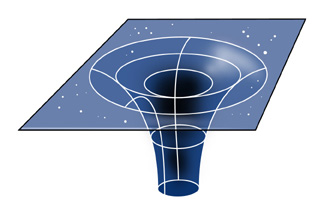|
Since
light has no mass how can it be trapped by the
gravitational pull of a black
hole?
Newton thought
that only objects with mass could produce a
gravitational force on each other. Applying
Newton's theory of gravity, one would conclude
that since light has no mass, the force of
gravity couldn't affect it. Einstein discovered
that the situation is a bit more complicated
than that. First he discovered that gravity is
produced by a curved space-time. Then Einstein
theorized that the mass and radius of an object
(its compactness) actually curves space-time.
Mass is linked to space in a way that physicists
today still do not completely understand.
However, we know that the stronger the
gravitational field of an object, the more the
space around the object is curved. In other
words, straight lines are no longer straight if
exposed to a strong gravitational field;
instead, they are curved. Since light ordinarily
travels on a straight-line path, light follows a
curved path if it passes through a strong
gravitational field. This is what is meant by
"curved space," and this is why light
becomes trapped in a black hole. In the 1920's
Sir Arthur Eddington proved Einstein's theory
when he observed starlight curve when it
traveled close to the Sun. This was the first
successful prediction of Einstein's General
Theory of Relativity.
One
way to picture this effect of gravity is to
imagine a piece of rubber sheeting stretched
out. Imagine that you put a heavy ball in the
center of the sheet. The weight of the ball will bend the surface of the sheet close to it.
This is a two-dimensional picture of what
gravity does to space in three dimensions. Now
take a little marble and send it rolling from
one side of the rubber sheet to the other.
Instead of the marble taking a straight path to
the other side of the sheet, it will follow the
contour of the sheet that is curved by the
weight of the ball in the center. This is
similar to how the gravitation field created by
an object (the ball) affects light (the marble).
will bend the surface of the sheet close to it.
This is a two-dimensional picture of what
gravity does to space in three dimensions. Now
take a little marble and send it rolling from
one side of the rubber sheet to the other.
Instead of the marble taking a straight path to
the other side of the sheet, it will follow the
contour of the sheet that is curved by the
weight of the ball in the center. This is
similar to how the gravitation field created by
an object (the ball) affects light (the marble).
Also
see Black Holes
& Search For
The Truth
We greatly
appreciate any comments on how we can improve
this website and its content. So please feel
free to write to us.
Pradipta Shrestha, Kosmandu
Astronomical/Cosmological Society Email
Copyright 2004 (Please feel free to copy
part or all of these pages, with acknowledgement
/ link back to source. Thanks)
|